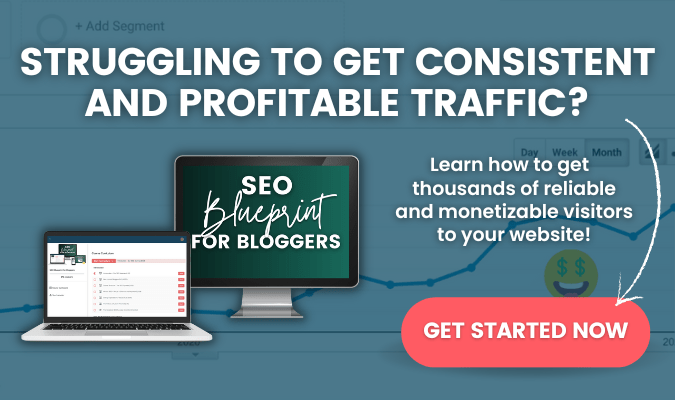We partner with bada$$ companies that offer products that help our readers achieve their goals! If you purchase through our partner links, we get paid for the referral at no additional cost to you! Read our disclosure for more info.
One of the biggest reasons people struggle to make money with their blogs is actually due to their writing — more importantly, their communication with their audience.
We made this mistake in the beginning too. We were blogging haphazardly with no clear mission other than dollar signs in the beginning.
It’s a major reason why our first blog failed so miserably.
We were creating content that we believed was truly awesome but without knowing anything about who our audience was or what they wanted.
It led to a lot of wasted time, energy, a failed product, a failed blog, and a lot of disappointment.
Great blog writing isn’t just about knowing your facts and putting them on paper (or keyboard).
Sure, getting your facts straight is important, but understanding your audience and connecting with them is far more important.
Finding Your Audience
One of the biggest mistakes bloggers make is writing about topics that THEY think their audience wants to hear.
We are guilty of this as well and it’s a BIG part of why our first blog failed.
But isn’t my blog about ME?
Not so much if you want to run a successful business from it…
I think Kim Kardashian is one of the few exceptions. She could probably write about choosing shoelaces and get a million page views and hundreds of thousands in affiliate income.
But for the rest of us, who aren’t celebrities, we need to master writing blog posts that our audience wants to read.
And to do this, you must first know who your audience is. You need to consider things like:
- The age of your ideal reader
- Their socioeconomic status
- Where they live
- Their reading/intelligence level
- And their hobbies
It’s not good enough to just know that you’re writing to women. You should know that you’re writing to a 45-year old mother of two children on a budget.
And you won’t know this information right away, and that’s okay. But it’s important to pay attention to it over time.
You can get demographic data on the people that are visiting your blog through Google Analytics:
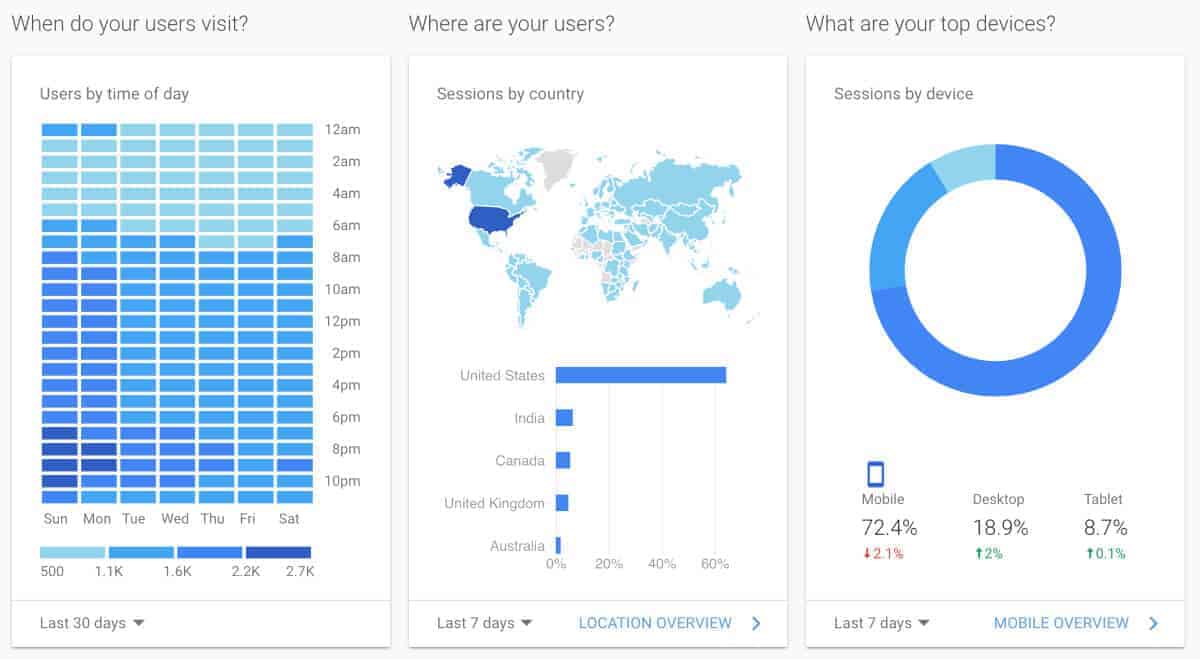
You can get information on the country, the time accessed, gender, and more.
BUT… an even BETTER way to get this information plus a whole lot of other details is to simply ASK FOR IT!
After our first blog failed and we were back at the drawing board for content and product ideas, we decided to ASK our audience what they wanted in our emails.
The responses POURED in and people poured their hearts out to us.
Ask your audience what they are struggling with and what they want help with. They will answer you. With more details than you would expect…
The best ways to do this:
- Ask your email subscribers.
- Ask your Facebook fans and in your Facebook group.
- If you don’t have an audience yet, make sure to ask at the end of your posts (for comments).
As your blog grows, your readers will begin commenting on your blog posts and replying to your emails with feedback about what they are interested in and need more help with.
Use these answers to help you decide what topics you should be writing about — along with the other methods outlined in the next section.
Connecting With Your Audience
If you aren’t able to communicate in a way that allows your readers to connect with you and start building a relationship, they’ll never sign up for your email list, purchase a product, or be likely to ever visit your blog again.
When you write great content and your audience feels that connection to you, they will naturally comment on your articles to ask you questions, to thank you for your blog posts, and often just to tell you how much they LOVED your post.
Here is a screenshot of some of the kind of comments that we receive on our articles:
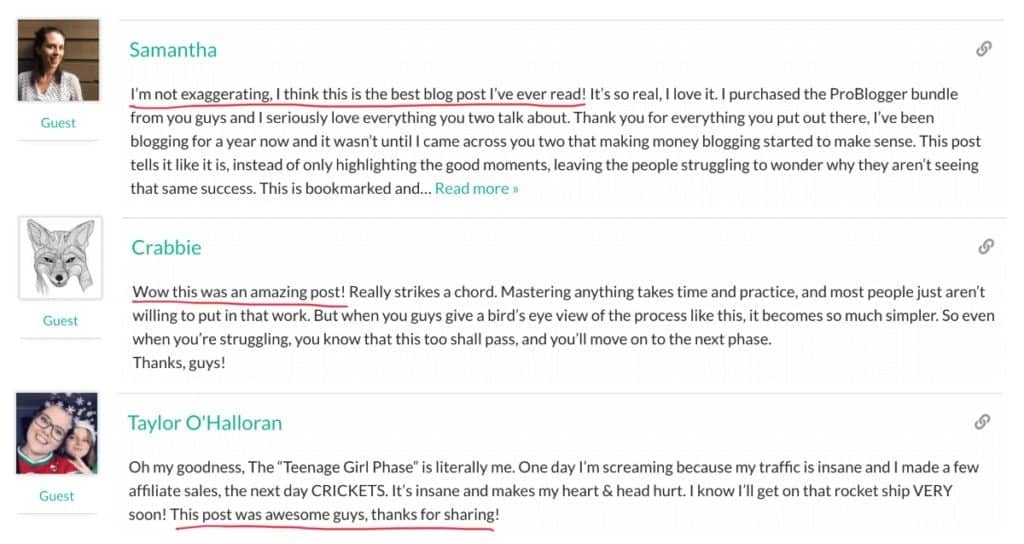
We wrote that particular article on the phases of blogging success, and it was written specifically to give some motivation to our readers struggling with getting their blogs off the ground.
We wrote honestly about the struggles that WE had in the beginning, and it helped our audience make a deeper connection to us.
This is how trust is built with your audience.
And connection and trust are the names of the game in the blogging world where competition is high and there are millions of articles competing with yours.
If you learn how to write a blog post like this, you will naturally create a more loyal and dedicated audience of readers and subscribers.
Writing a good blog post requires you to juggle several different things at once, and we’ve got you covered on just about everything in this article.
Okay, let’s talk about how to write a blog now!
How to Write A Blog Post Readers Will Love in 6 Steps
The very first step is deciding what the heck you’re writing about!
1. Find Your Blog Topics
Use what you learned in the above section when you are deciding what topics to write about.
But having those ideas isn’t enough… You need to also use the following methods to help you interpret the information your audience is giving you
You need to also use the following methods to help you interpret the information your audience is giving you
Use Keyword Research
The blog topics that you write about should be centered around specific keywords that your audience is searching for.
Proper keyword research can take some of the guesswork out of this process!
If you’re working on Google SEO, check out our article on keyword research tools.
If you’re driving traffic from Pinterest, then Pinterest search is one of the best ways to get ideas for new blog topics!
All you have to do is go to Pinterest.com and type in a general topic into the search bar.
In the example below, we are using the keyword “yoga:”

You’ll see that some popular suggested search topics related to your keyword automatically populate under the search bar.
You can also click on any of those keywords to generate additional keyword ideas on the next page:

This is a very simple way to generate keyword and blog topic ideas for your content with the assurance that people are actually SEARCHING for those topics on Pinterest!
Some other great keyword research tools that we use are:
- Ubersuggest (best free tool)
- SEMrush or Ahrefs (best paid tools)
The large majority of your content should be created based on the things people want, need, and are actually searching for.
Popular and Trending Topics
People love new things. New cars, new clothes, new boyfriends.
We all do.
Because people love new things, there will always be a new diet, a new tactic, or a new product that comes around swooping up everyone’s attention.
Trendy headlines are irresistible to readers because of the novelty factor. They know you’re going to tell them something new and interesting that they haven’t heard before.
And your audience wants to hear your opinion on these topics!
Even if your opinion isn’t favorable… Your followers want to hear from you and know what your thoughts are on trending and popular topics.
You are an authority figure on the subject to them and having an opinion matters!
BUT make sure this makes up a much smaller portion of your blog posts because trends do come and go. This content doesn’t always stay relevant.
Still, it can be a fun piece of content for your audience to read!
You can also see topics that are trending with Google Trends or try running a search for “your niche + popular trends in [current/next year].”
Content That Connects
While you should be sharing your story and personality in ALL of your posts to better connect with your audience, it can be hard to connect when every blog post is a “list” or “how to”.
That’s why you can and should mix it up once in a while.
Some of your blog content should always serve the purpose of helping you build trust and connect better with your audience.
Here are some great blog topic ideas for a quick mix-up that are designed to help you CONNECT with your people:
- What’s your personal story? Tell the world in a timeline of dates posts. [See our About Us page].
- Share some of your favorite memes and photos that make you laugh in your content.
- Is there something about your industry that frustrates you? Talk about it.
- What are your goals (related to your niche) for the coming week, month, and year? Share them!
- Share your opinion on a controversial topic. You will generally isolate some but build a much deeper connection with many more.
- Interview someone awesome in your industry.
- Write a blog post about the biggest mistakes you’ve made in your journey to [relate topic to niche].
The best part about writing this type of blog content is that it’s both FUN to write and will help you create a deeper connection with your audience.
They are both good for your soul, your audience, and your business.
Win-Win-Win.
2. Plan Out Your Content
Once you have selected a blog topic for your new article, it’s time to plan out what you would like to say in the article.
You can opt for the method of “just start writing,” but it could lead to babbling and a disorganized article that doesn’t hit on all of the key points your readers are interested in.
My favorite method is to simply open up a new Word document with my blog title at the top and first write out the major key points that I believe I need to touch on.
After settling on the most important points of interest for the article, I then begin to fill in the outline with what I want to say about the topic.
It’s often easier to write in a Word document rather than in WordPress because it’s less distracting. You can copy the content over when you’re finished.
Okay now that we’ve got the preparation stages covered, let’s get into the good stuff!
3. Create Compelling Headlines
In this step, you should use the keywords that you found earlier to come up with great, click-worthy headlines.
Your headlines and keywords should tell your audience that your content is the answer to their prayers, er I mean searches…
The point is you need amazing headlines that all but force the reader to click through to your post.
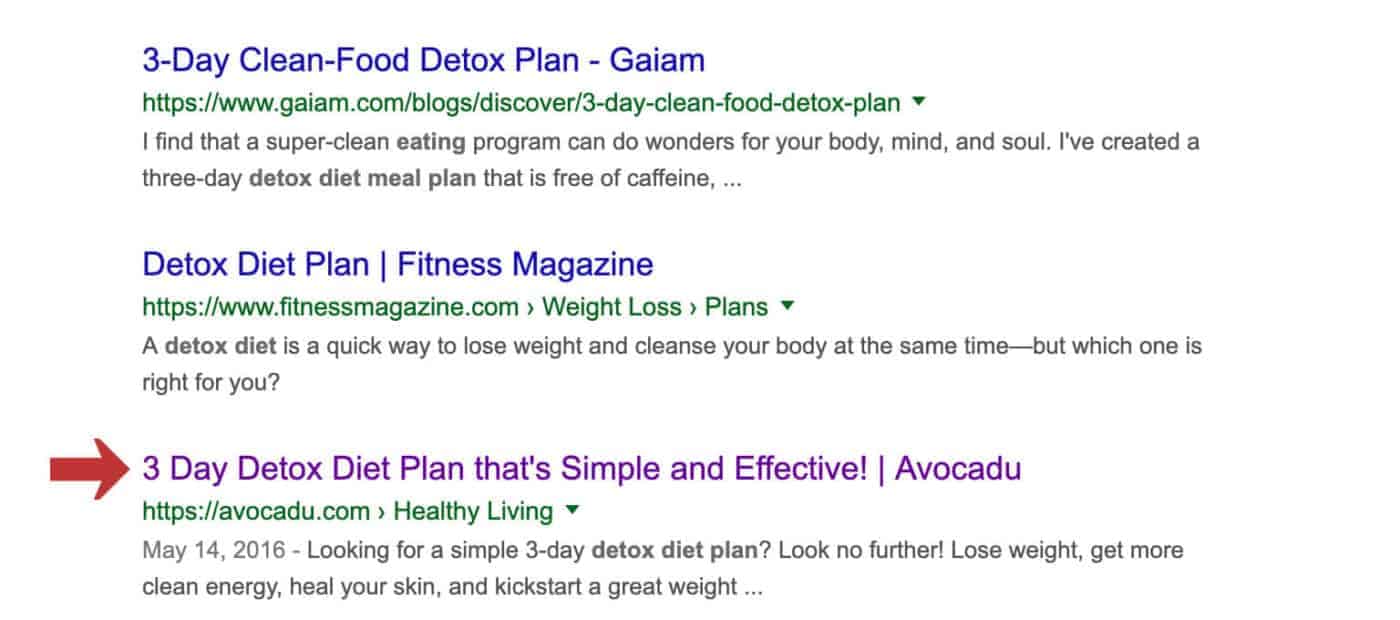
In the above example, this headline goes a step further than the other two headlines because it adds a descriptive element: “Simple and Effective.”
It still ranks below two articles that have worse headlines because they have a much higher domain authority than we do, but having the better headlines is what gets you clicks despite people ranking above you!
It can greatly help you move up in the ranks!
And, to show up in search, the keywords in your post have to tell the Google gods that the content is filled with the juicy goodness people are looking for.
Remember, your audience wants to know you can solve their problems or they’ll bounce.
Headline Ideas
- 5 Things You NEED for the Perfect Vacation
The reader worries they forgot something for their vacation, so they have to open the magazine to learn more
- 7 Ways to Make Him Want you NOW
The word “now” creates a serious sense of urgency, giving women FOMO if they don’t flip through to that article
- 10 Drool-Worthy Thanksgiving Recipes
If I’m cooking Thanksgiving dinner, I want my guests drooling.
- What You’re Doing Wrong in the Gym
The fitness buffs will be dying to know if this article holds the key to why their muscles aren’t as big as they’d like them to be.
Now, some of the magazines also have awful, truth-stretching clickbait headlines. Or images that don’t accurately represent the content behind it.
DO NOT do this. You will only damage the relationship with your reader and they’ll likely not bother with the rest of your content.
Hopefully, these ideas are inspiring you to come up with more compelling headlines of your own and to use the right keywords to get in front of your ideal audience.
With practice, you’ll eventually be able to come up with buzz-worthy headlines on the fly. I swear Alex can do it in his sleep!
4. Hook Them With a Spellbinding Intro
Remember that opening scene in the movie that glued you to your seat?
Create that!
The headline and keywords got your reader’s attention, now you need to use your own super glue so they will stay for more.
Our best recommendation is to start your post with a unique story that will endear readers to you.
This also sets your content above the rest because no one can duplicate your story. It’s how your readers feel connected to you and you should incorporate it into everything that you do.
For example, if you’re a beauty blogger and your topic is about cystic acne, your post might start with a story about when you were in high school, and plagued by the large bumps on your own face.
Walk the reader through the shame you felt as your bumps worsened before they got better, and the steps you took to heal your skin. Your readers should feel your pain as their own and anxiously await your resolution.
If your goal in writing this article is to promote a specific product, weave it in by explaining how that product helped you get rid of your own cystic acne problem.
Make it clear the post they are reading will solve their problem too.
In other words, don’t bait and switch them! That’s the fastest way to lose a reader forever.
5. Give Them a Reason to Stick Around
You’ve pulled the reader in. They’re in your front door ready to eat up all you have to offer.
When you are writing the main portion of your article, make sure to give them the “what” to do but not necessarily all of the details on “how” to do it.
You want to give them some details on the “how,” but remember that you should save most of the goodies for your paid content (products).
Make sure to also include:
- Nice, relevant pictures that add to the story
- Subheadings, bullet points and short paragraphs for easy reading
- Case studies and relevant information to set you up as an expert on the topic
6. Solve Their Problem
All you need now is to close out with a big finish that will leave them wanting more.
However, there is a delicate balance with this step. Because the point of the post isn’t to solve ALL of their problems.
You need to provide enough information to deliver on what your headline promises, but you need to finish on a point that lets them know that this is just the tip of the iceberg.
This is the cliffhanger of the movie that makes you want to see the sequel. It’s where you finish the post with a call to action that does one of five things:
- Direct the reader to another post to read more of the goodness you’ve written
- Offer them a link to buy a product which can solve even more of their problems, or better solve the one they are currently reading about
- Convince them to sign up for your email list
- Inspire them to share this post with their friends on social media or via email
- Persuade them to drop a comment about the post they have just read
A call-to-action is simply the action that you want the reader to take after reading your post.
You should have one, clear call-to-action. Creating multiple will confuse your reader and potentially lead them to not take any action.
Here is an example of one of ours from our post on hot yoga:
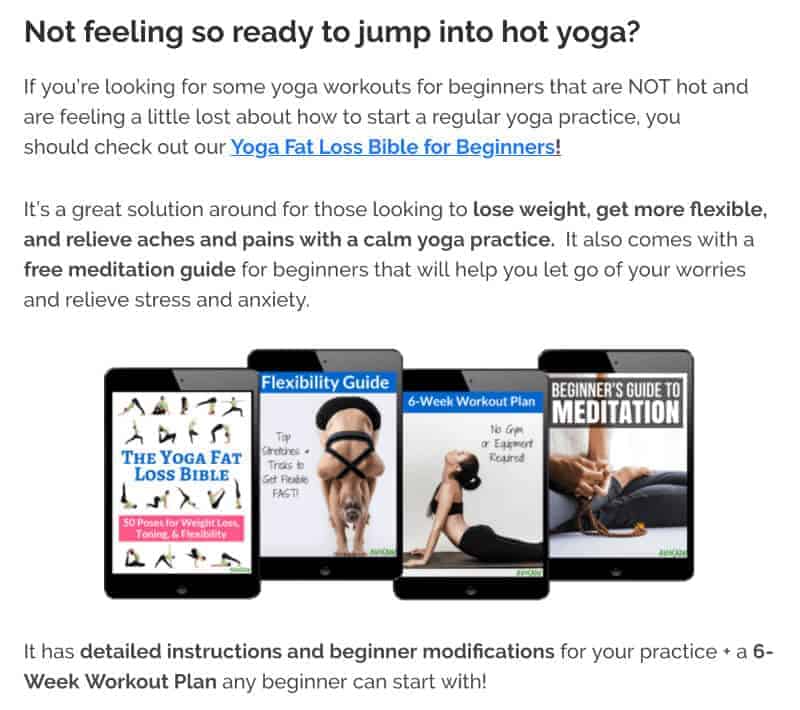
Every blog post should have at least one call-to-action at the end.
5 Best Blog Writing Tips for Both Beginners and “Experts”
Now that you know how to write a blog post your readers will love, let’s move on to some more blog writing tips that can help even more.
1. Assume Blog Readers are at Level 1
When Alex went to the Traffic and Conversion Summit by Digital Marketer a couple of years ago, he heard a presentation by Donald Miller (of Storytime Blog) that turned out to be one of the most valuable marketing lessons we have learned thus far.
When it comes to communicating with your audience, assume that you are at a level 10 and they are at a level 1.
And no, that doesn’t mean that you should assume your audience is stupid!
When you write and communicate in any way, you do it from your point of view, your experiences, and with all of your prior knowledge about the topic you are discussing.
You generally know a LOT more than your audience does about that topic, so you tend to skip over the ‘smaller’ details that you feel are less important but that end up actually being crucial to your audience to understand your message.
Assume that your audience knows virtually nothing about the topic you are discussing so that you don’t leave out any important details that they need to fully understand your message (and purchase your products!).
This is even more important when you are writing emails and sales pages to make sales.
Here is an example of one way you can incorporate this concept into your writing.
Don’t just tell someone how to do something. Remind them of WHY they need to do it. – Obviously, they should already know why they need it but the reminder helps them understand you better.
It may feel a little like you are communicating unnecessary details at first, but you’ll begin to get used to writing in this way and your readers will thank you for it!
2. Write Like You’re Talking to a Friend

I think a lot of bloggers tend to try to be “professional” when they write blog content and they get overly focused on sounding “official” or like an “expert.”
While professionalism is important, you don’t need to sound detached or ‘stiff’ to be recognized as a credible source.
I like blog writing in the way that I would communicate my thoughts or feelings on a topic to a friend or group of friends.
There is some level of comfortability there but it’s not as formal as if you were presenting a speech in front of a group of strangers or trying to impress your science teacher.
Try to remain relaxed and confident in your blog writing style. Put on some great music if it helps you get in the zone.
Next up on our list of blog writing tips sort of ties into the point above but takes it one step further.
3. Speak From Your Experiences
We touched on this briefly earlier as it related to choosing blog topics, but now we are going to take it a step further as it relates to your writing style.
It’s time to stop blog philosophizing.
What’s that?
It’s when you talk about your thoughts and assumptions instead of your experiences.
Writing a blog post is really just about vomiting your thoughts on a subject out onto your keyboard, but writing truly great content is more about injecting your actual and personal experiences into the subject you are writing about.
If you’re talking about pets or parenting or whatever and you have hardly any experience with that subject, people will read through you like a Dr. Seuss book.
This is honestly the most important point in this entire blog post and the reason why Alex and I receive so much positive feedback on our articles and overall communication relating to our blog.
The most common positive feedback that we receive is that we seem very “honest” and “transparent.”
In the world of the internet, honesty and transparency are two characteristics EVERYONE should strive for – regardless of your blog niche.
It’s not enough to talk to your audience with that level of comfortability like you are a friend, you should also treat the relationship with a level of familiarity that allows you to instill some trust in them.
You do this by sharing personal experiences, thoughts, and feelings on the topics that you are writing about.
This is another reason why we ask people to be careful with the blog niche that they choose.
The more knowledge and experience you have about a subject, the better you will be at communicating your thoughts and opinions to your audience in your writing.
Without a personal touch, your articles will fall flat against the rest of the competition out there. There will be nothing that sets YOU aside from everyone else.
When I write articles now, I first think about the topic(s) my audience needs the most help with.
Then, before I start writing, I think about my personal experiences with that topic and how I can turn those experiences into important lessons for my readers.
These are all things that you need to think about when preparing and writing your blog articles.
Don’t forget that this is also extremely important when it comes to making money with a blog and selling products!
4. Don’t Obsess Over Blog Post Length
Length doesn’t always imply strength when it comes to writing blog posts.
Longer articles generally rank higher for Google SEO because it means that people are spending more time on your page, and Google takes that into consideration in their algorithm ranking.
BUT…
If you fill your content with fluff or other bullshit just to hit some arbitrary number for Google SEO, people will bounce from your website anyway and this will HURT for ranking in Google.
There are no magic numbers here, folks.
All of our blog posts are at least 1,200 words, but we try to keep many of them closer to 2,000 – 2,500 for Google SEO.
That being said, when I’m writing, I don’t look at the word count in my Word document until the article is finished.
If you obsess over word count while you are writing, you’ll end psyching yourself out and the quality of your writing will end up suffering.
Once you’re finished writing, take a look at the word count. If you’re below 1,200 words, look for areas that you can expand upon and provide more details to help support your key points.
Never fluff to hit numbers. Make sure that you are only ever adding additional value to your content.
5. Make Sure Your Content is Very Readable
This blog writing tip is fairly straightforward, but it does go against everything you were ever taught in elementary school.
Are you writing a novel?
No???
Then your paragraphs shouldn’t look like this:
Unless your name is Jon Grisham and you tell ridiculously compelling stories, you need to cut down those paragraph sizes and make things a little less intimidating to read. Many of the readers who hit that blog are going to visit the page, see that massive block of text, and bounce like a rabbit on a trampoline. Do you see how annoying it is to read a paragraph this long? What ends up happening is that people entirely miss the MAIN POINT that you are trying to make in your sweet true-author-like paragraph. It goes like this: content, content, MAIN POINT, content, content, content. And then I have forgotten what the biggest takeaway was. Now think about if the ENTIRE article was written this way? It’s SO much easier for readers to think “I don’t have time for this. I should be doing something else.” and they BOUNCE!
In this day and age, people are constantly consuming information all day long, whether that be in their personal time when planning adventures or vacation or at work (whether you’re a blogger or not).
Competition for webspace and readers’ eyeballs is only increasing, so it’s important to not only catch people’s attention but also to KEEP IT.
The vast of people aren’t just slowly browsing through articles like they would a casual stroll through the park on Sunday.
They’re clicking many different articles and scanning the information for things that interest them.
This means that your content needs to be easily readable and scannable so that the reader can tell immediately whether your content is worth their time. You can do this through:
- Using proper heading tags to make headings larger (also helps for Google SEO)
- Including a table of contents or an overview of key points at the beginning of your article
- Bolding, italicizing, and/or underlining important text
- Making sure hyperlinks are in an easily identifiable color
- Spacing out sentences into shorter paragraphs (rather than large chunks of text)
These are all strategies that we incorporate into our articles. The last point is especially important and one that many people don’t bother with.
In elementary school, you were taught to write longer paragraphs that separated different ideas.
In blog posts, you should write in more of a conversation style because it makes your content easier to read and important point easier to identify.
Blog Writing Tools
Below are a few other blog writing tools that we incorporate into our articles to make sure that our blog content is the best it can be!
1. AI Writing Tools
Using an AI tool to help you write will change the game for you. It will help you write more content, better, and faster.
What used to take us days now takes us just a few hours. While AI can write an entire blog post for you, it’s actually best to use it as a writing assistant to help you research and get inspiration.
Our favorite tool is Jasper AI. It has tons of different templates that you can use for every use case you can think of.
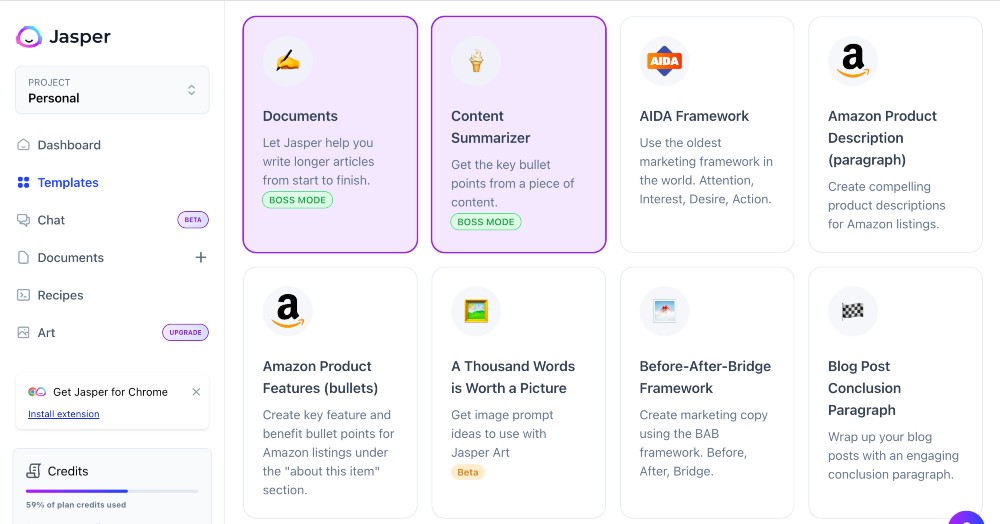
2. Making Your Blog Posts SEO-Friendly
Even if you don’t plan on paying much attention to getting Google traffic, you should do what you can to “passively” rank better in the Google algorithm.
If you do this, you will naturally begin to get more Google traffic over time.
The best way to learn more about how to do this is by downloading the Rank Math SEO plugin.
They have an easy-to-understand score-based system, along with a red, orange, and green light system to help you improve your blog posts to make them more SEO-friendly.
If you’re looking for a more advanced SEO tool to get the most out of your blog writing, Surfer SEO is what we use to optimize our posts for SEO.
It will tell you:
- how long your blog posts should be
- what keywords to use
- how may paragraphs, headings, and images you should use
- and more!
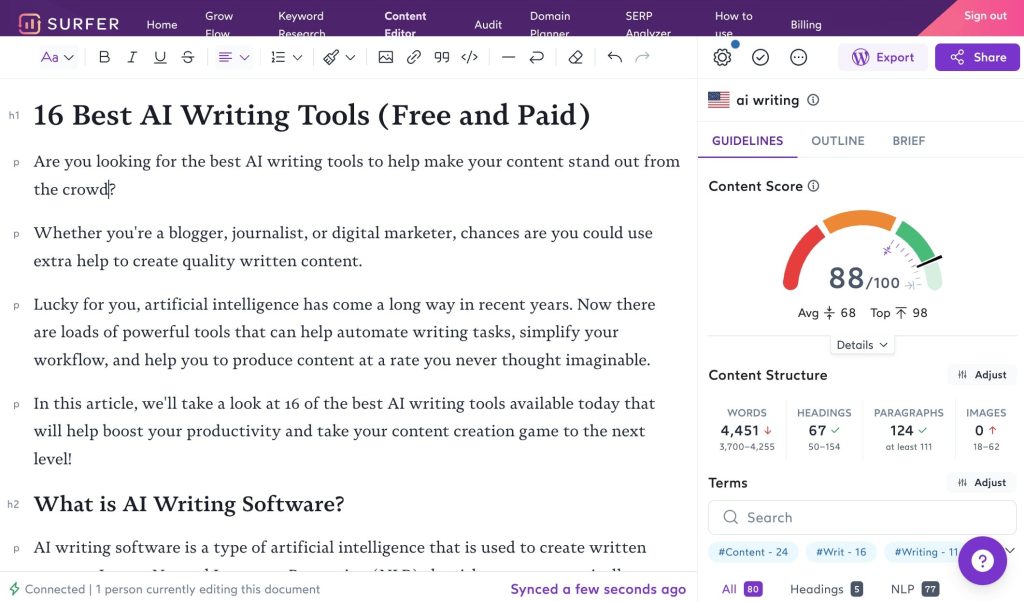
3. Optimizing Your Images
Site speed is incredibly important for both sales and SEO and the larger the sizes of your image files are, the longer it will take your website to load them.
There are two steps that you need to take to optimize your images BEFORE uploading them to WordPress:
- Resize: Make sure that the image is not larger than it needs to be to display how you want it on your site. You can use a free web-based app like BeFunky or Fotor for this.
- Compress: After resizing, you need to compress the file size to the smallest possible size you can get it to without reducing the quality below a level you’re comfortable with. You can do this through free sites such as Optimizilla or TinyPNG.
You can also download plugins to help with this, but it’s important to still take these steps before uploading so you don’t bog down your site with too many plugins or large images.
4. Proofreading and Editing
Because you are writing your blog posts in more of a ‘conversation’ style, it’s a lot easier to make grammatical mistakes and other errors along the way.
I know that when I’m on a roll, I type really fast to try to keep up with my thoughts, and I tend to make a lot more errors.
It’s important to ALWAYS read over your content at least once before publishing, but I recommend giving it one read-over immediately after you’re finished and then another before you actually publish the article.
Remember that it’s much harder to catch your own mistakes when you read quickly and know what the article says already. If you can get another pair of eyes on the blog post, that is ideal.
Otherwise, use Grammarly! It’s an online tool that you can use to check your grammar and spelling. There are both free and paid options, so you can make the call on what level of help you need.
This is a tool that we personally use every day and absolutely love it! I have the browser extension installed on my computer, so it even checks my grammar on Facebook and other websites!
I think that covers just about all of the best and most important blog writing tips that Alex and I personally use when writing our blog posts, but if you think I missed something or you have a tip to add, please feel free to leave a comment below this article!
We’d love to hear from you!
